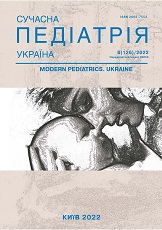Hereditary microspherocytosis in children: diagnostic algorithm of typical and atypical course
DOI:
https://doi.org/10.15574/SP.2022.126.82Keywords:
hereditary microspherocytosis, hemolysis, anemia, differential diagnosisAbstract
Anemic syndrome in a child in the practice of a primary care doctor is a frequent problem that requires a balanced differential diagnosis. Features of the course and difficulties in the diagnosis of hemolytic anemia require attention to key points. Hemolytic anemia is characterized by a reduction in the life span of erythrocytes, which is clinically manifested by jaundice due to indirect hyperbilirubinemia, splenomegaly, and skeletal deformities during a long course. Considering the seriousness of the prognosis for hemolytic anemia, it was considered appropriate to demonstrate specific practical nuances of managing such patients in specific clinical cases.
Clinical cases clearly demonstrate the need for careful collection of family anamnesis and additional examination of brothers/sisters, parents when hereditary microspherocytosis is suspected. Diagnostic criteria of hereditary hemolytic anemia are: jaundice (due to indirect hyperbilirubinemia), splenomegaly, anemia, reticulocytosis, similar cases in the family. It is presented a case when hemolytic crises in a child were accompanied by a transient increase in liver transaminases, in the absence of changes in ultrasound examination and negative markers of viral hepatitis.
Conclusions. An anemic syndrome established in a child in combination with reticulocytosis requires a targeted examination for hemolytic genesis of anemia. At the same time, it should be remembered that in the case of an atypical course of hereditary microspherocytosis, the patient needs a comprehensive examination and dynamic monitoring of the course of hemolytic anemia in order to prevent serious complications.
The research was carried out in accordance with the principles of the Helsinki Declaration. The informed consent of the patient was obtained for conducting the studies.
No conflict of interests was declared by the author.
References
Banadyha NV. (2019). Anemic syndrome in children: through the prism of pediatric and hematological problems. Modern Pediatrics. Ukraine. 8 (104): 24-32. https://doi.org/10.15574/SP.2019.104.24
Güngör A, Yaralı N, Fettah A et al. (2018). Hereditary spherocytosis: Retrospective evaluation of 65 children. Turk J Pediatr. 60 (3): 264-269. https://doi.org/10.24953/turkjped.2018.03.005; PMid:30511538
Rothman JA, Stevens JL, Gray FL et al. (2020, Nov). How I approach hereditary hemolytic anemia and splenectomy. Pediatric Blood & Cancer. 67: 11. https://doi.org/10.1002/pbc.28337; PMid:32391969
Papp ZE, Chincesan M, Horváth AM et al. (2019, Nov). Hereditary spherocytosis in the experience of two pediatric clinics from Targu Mures. Orv Hetil. 160 (45): 1798-1803. https://doi.org/10.1556/650.2019.31345
Schrier SL. (2018, Feb). Microcytosis/Microcytic anemia. URL: https://uptodatefree.ir/topic.htm?path=microcytosis- microcytic-anemia.
Downloads
Published
Issue
Section
License
Copyright (c) 2022 Modern pediatrics. Ukraine

This work is licensed under a Creative Commons Attribution-NonCommercial 4.0 International License.
The policy of the Journal “MODERN PEDIATRICS. UKRAINE” is compatible with the vast majority of funders' of open access and self-archiving policies. The journal provides immediate open access route being convinced that everyone – not only scientists - can benefit from research results, and publishes articles exclusively under open access distribution, with a Creative Commons Attribution-Noncommercial 4.0 international license (СС BY-NC).
Authors transfer the copyright to the Journal “MODERN PEDIATRICS. UKRAINE” when the manuscript is accepted for publication. Authors declare that this manuscript has not been published nor is under simultaneous consideration for publication elsewhere. After publication, the articles become freely available on-line to the public.
Readers have the right to use, distribute, and reproduce articles in any medium, provided the articles and the journal are properly cited.
The use of published materials for commercial purposes is strongly prohibited.

